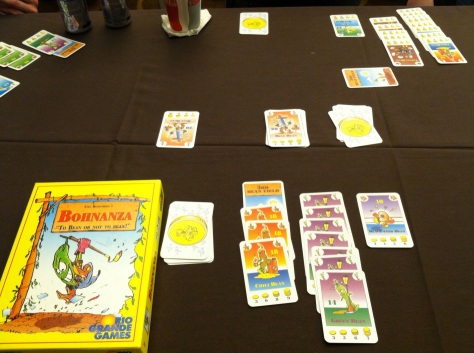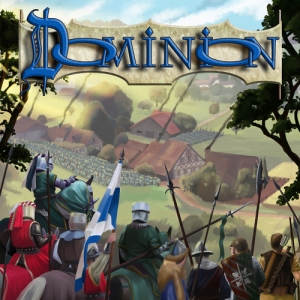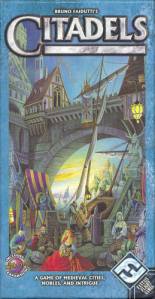What the heck kind of name is Bohnanza (Rio Grande Games, 1997)?? “Bohne” is german for “bean,” Bohnanza is a pun for “bean bonanza.” Glad we got that out of the way – on to the important stuff.
This is perhaps one of the most interesting, and well-disguised, rummy games I have ever come across. At its most basic, players are simply trying to create the largest sets of cards they can, in order to then cash them in for coins. Whoever ends the game with the most coins wins the game…BUT… it isn’t that straightforward. The creators of Bohnanza deserve a lot of credit for keeping with the “bean” theme while allowing for a very unique and interactive game.
There are 11 types of bean cards – as opposed to the four suits in an ordinary deck of playing cards – and each bean type has a different number of cards (each card is labeled with the total number of its type): for example, there are 6 “Garden Beans” and 24 “Coffee Beans,” and each Garden Bean card is labeled with a 6, and each Coffee Bean card is labeled with a 24. Each card also has an amusing depiction of that type of bean, and at the bottom there is a range of coin values.
As players earn cards, they “plant” them (i.e., they play the cards in front of them), but they are initially limited to planting two fields only – so they may play only two types of bean in front of them. At some point a player must “harvest” a crop of beans they have planted. The number of cards in the harvest then earns them the number of coins listed on that card; 4 coffee beans earns a player one coin, while 10 of them earn three coins, and so on.
Interestingly from a design perspective, the game does not come with separate coins for scorekeeping; rather, coins are depicted on the card backs of each bean. This is important to the game play because as bean cards are harvested, most of them go to a discard pile that is recycled for continued play. However, the first few cards of that stack are turned over and become coins, owned by the harvesting player, and are thereby eliminated from the game.
Once players have started earning coins, they have the option of purchasing a third bean field for three coins – allowing them to plant, then harvest, a third type of bean. A third field comes in handy because the rules force players to make some tough decisions when it is their turn…
Players start with five cards. The cards MUST remain in the order in which they were received. Wow, that’s different; it also affects everything else about the game. Players can see their hands, and hold them so that others cannot, but they may not rearrange the hand. On a player’s turn, he or she MUST plant the top card, and may also plant the second. Then they draw two more cards and turn them face up; they have the option of donating, or trading these cards, or they can keep them for planting. Finally, the player must draw three cards, adding them one at a time to the back of their hands.
The trick here is to plant bean fields that might earn the most coins, and that determination is made by seeing what else is in one’s hand, and also what other players have planted and have negotiated for. Often a player is forced to harvest one field in order to plant another, even though the harvest yields little or nothing. Thus, during the draw phase, it is important for a player to initiate shrewd trades and gain the beans they have already planted. One must also be active in trading during other player turns, for the same reason.
There are a lot of nuances in a game like Bohnanza that I won’t go into here, but there are a great many fans of the game all over the world. In fact, there are at least 17 editions of Bohnanza, some incorporating new rules, and some with new cards or new themes. The Fan-Edition uses art work from players everywhere (see pic above).
It’s not hard to recommend Bohnanza to any gaming family, or any group of people who like games in general and card games in particular. It comes in a reasonably small box, and is as easy to travel with as any large deck of cards. It encourages interaction, risk-taking, probability, and planning, and would be great for any players aged 10 and up. It’s officially recommended for 12 and up, but I think a bright youngster can figure it out.
Now, go play!






























